May 4, 2013 Canon 6D and Samyang 24 F1.4 Badlands Milky Way and Zodiacal Light
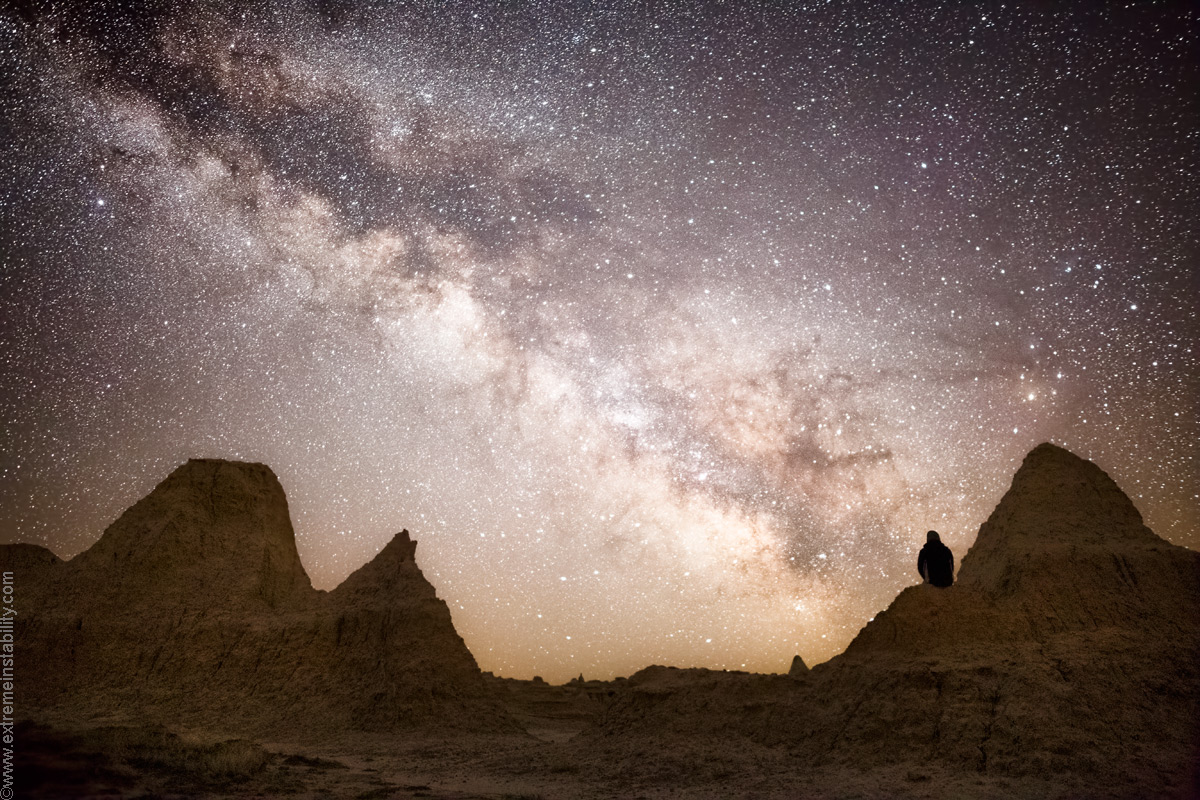
So last fall I decided to jump back up to full frame. Wound up with a used 5D II, Samyang 14mm, Zeiss 21 and a Sigma 50 to go along with the 100-400L. Pretty set then. I then got the idea I wanted to have two cameras for any close tornado interceptsand other situations where it would be great to have two bodies ready, with different focal lengths on them. So I picked up a Canon 6D with the 24-105L kit. Not much later I got buyers remorse and realized I did not need all this. I could easily get by with my old T2i and a 50mm on it for the second closer body. See if a tornado is passing close by, it's great to have an ultrawide angle lens on. But it would also be nice to have something a bit closer in. I shoot video too, so there's really no time to be switching lenses. Anyway, I decided to sell the 5D II I bought six months ago and the 24-105 that just came with the 6D. I lost about $550 on the 5D II since I had sent it to Canon to be serviced and well selling it for $300 less than I just bought it. I'm an idiot sometimes, especially this jumping to full frame and then back to crop stuff, which should be over now. Selling the 5D II and the 24-105 put almost $2000 back in my pocket, which felt better. But it also put a lens buying bug right back into me. Kept thinking of a macro lens but knowing it'd be a waste of money, as I'd never use it. But kept thinking about it. Then kept thinking of a used 85L, which also wouldn't serve me much use. I wanted an ultra fast wide angle but that is only 24mm and above and I already had a 14 and a 21, both which are really damn nice. Shooting the Milky Way, Zodiacal light, Auroras and even storm structure at night with an ultra fast wide angle got the best of me though and I picked up a Samyang 24mm F1.4 for $500. This was really all around a great move. Dump the second full frame body/5D II idea and 24-105 kit lens and have some change with a 24mm F1.4 to go with the rest I already had.
I 2 day air'd the lens with the idea of going to the Badlands soon to shoot the Milky Way. Knew the moon would be getting better and rising like 2-3 a.m. or later. Obviously important to factor that in, with knowing how high up the Milky Way would be when. I used wunderground's explore astronomy deal to see where things would be and when. Then google earth night view to make sure what constellations made up the good parts of the galaxy. I was there last spring and knew it would at least be higher up than that time, given it was a month later now. I for sure wanted to maximize all ops, so I wanted at least some moon to be there for part of it, but for sure there to be good views of it without any moon. I knew about when would be good, just needed the lens to get here and to factor in cloud cover. It pays to be a storm chaser with some weather background for that part, even as simple as it might be.
But then the snow storm hit May 1st. Knew it was coming but not sure how well it would pan out. It panned out well. I was not about to miss a historic snow event. So I stuck around here during that. May 1-2, 2013 Historic Eastern Nebraska Snowfall 6 inches of snow in eastern NE May 1st! For reference Omaha has 3 records of measurable snow falling in May and the most was 2 inches. They get 3 out of this, while my town just north of there gets 6...truly historic. I chased that around town for 6 hours the night of the 1st, then 6 hours the next morning early after little sleep. During that 2nd day I sorta kicked my ass in the snow, making a snowman and otherwise exhausting myself roaming the hills.
By the 3rd I was worn the hell out. Here is the thing though. The snow maker was supposed to cut off and become a big upper level low that would pivot back westward on the 3rd. The 2nd actually looked the biggest lock for cloud free conditions in the Badlands but that just wasn't happening after documenting the snow event. The 3rd was really interesting as far as cloud forecasting. Behind these big upper level lows you will often get super drying as air sinks there. The problem was the models were insisting a big batch of moisture/clouds would be moving southeast across Wyoming and Montana. Looking at satellite the morning of the 3rd confirmed this, big nasty clouds moving southeast. But what was prog'd to happen was, as the upper low began moving back west, it would halt those clouds and leave a sinking area of really dry clear air. It was such a small area though. Any shift east or west with things and could be in the Badlands with clouds.
The other problem was I saw potential chase days 8th through the 10th well south and I have a harder time pulling the trigger on those if I just went somewhere. Thought, I don't want to hex myself going to the Badlands then blowing off what turn out to be good chase days. The other thing is, if you go shoot all night and get what you want, there's little sense in staying there. But the problem is you never got any sleep. The thought was, well I could try and nap for a couple hours on the 3rd before leaving, leave, shoot there all night, then leave for the drive back home before sunrise. It's almost 6 hours away though. Those drives home after doing that can truly suck. (and it did)
I get crap ready and then take that 2 hour nap, not thinking I'd actually go but to be safe I'd get the nap in, which I needed anyway. I wake around 1pm and the clouds in MT/WY were really concerning. One just didn't feel real sure that the big low to the east pivoting back west would stop all the moisture and keep it super clear like it gets behind upper lows. Because really I wanted SUPER clear. You can see this well on water vapor images. Wanted in the dry max so the stars seem touchable.
Friend was considering going and said he was game now. I was like alright, lets go for it. Whole drive there I pretty much refused to look at the satellite loop. It's better to just not know than to look and then worry more because of what you see the whole way there. Half way there I look though and was still fairly concerned. The concern grew higher as I was within a couple hours and could see the clouds. Well the models nailed it. Amazingly this big upper low halted those clouds in their tracks and continually eroded them, just west of South Dakota. As well on the border.
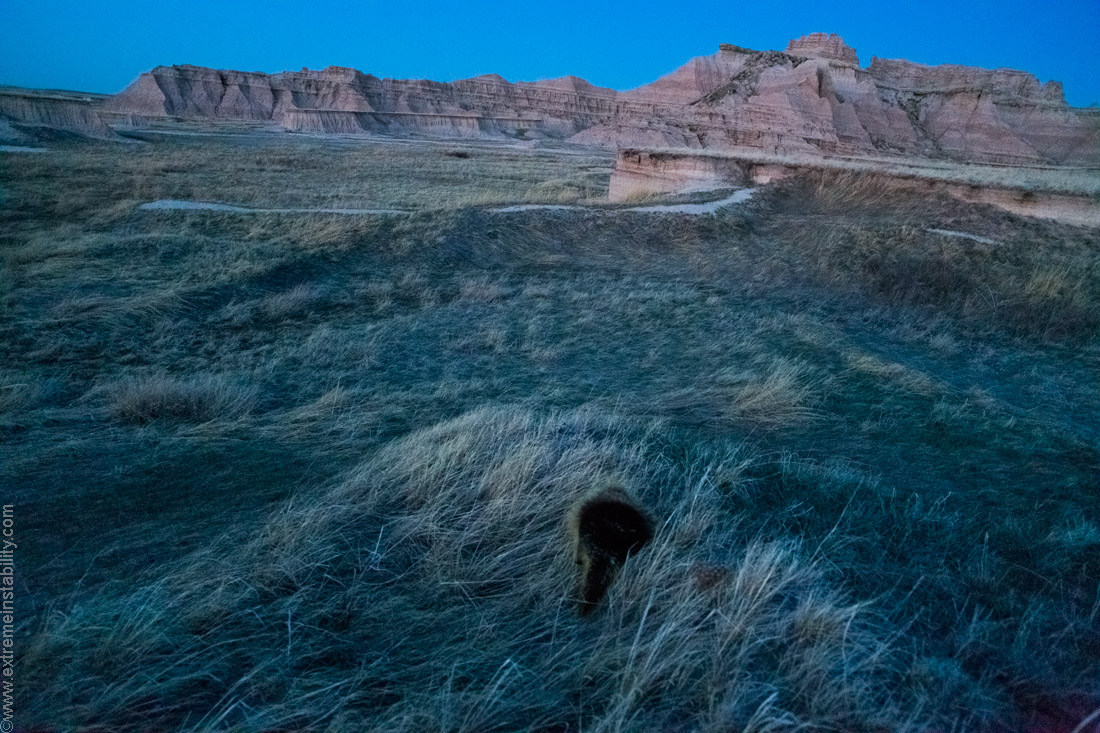
I'm in the badlands all of 2 minutes before I see something cross the gravel road ahead of me. I pull over and give chase. A porcupine! Never seen one before. A big sucker. I was amazed at how he refused to let me see his face at all. He gets over by that rock edge and stops. All he'd do is turn his butt towards me, showing me the needles in his backside.
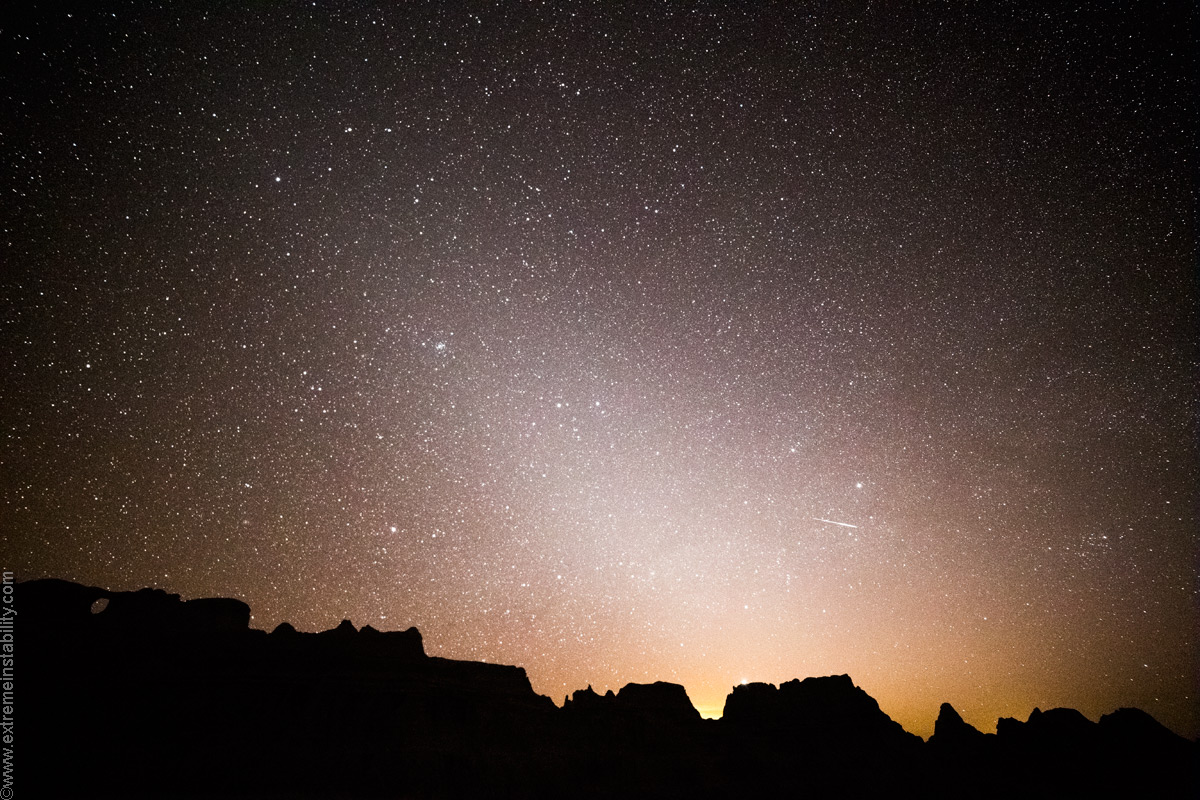
17 seconds F2.8 12,800 ISO Samyang 14mm
We wait on darkness, watching our clouds to the west continuing to
die. We got rather pumped fast, since during twilight, it seemed we were
getting stars damn early.
I rented the Canon 5D III and 14L last spring for this place and knew what ISO I could get away with on it. I also knew the 6D was even better at ultra high ISOs. I just didn't know how much and really what I should use and not use. I seemed to remember the 5D III being ok 8,000 to 10,000 but at 12,800 it felt like you were pushing it a bit much. Turns out there was no worry with the 6D at 12,800 for this. Like a breeze. So amazing.
Anyway, pictured above is the Zodiacal Light right above Rapid City, which is the orange glow(Rapid City). Either a meteor or a satellite flare there. There were a lot of both.
Shooting the Zodiacal light I began to wonder if I wasted money buying the 24mm F1.4 Samyang, because it just wasn't wide enough. For the Zodiacal light you really need the dark sky included for the contrast.

25 seconds F2.8 12,800 ISO Samyang 14mm
Thank you far off car on our gravel road!
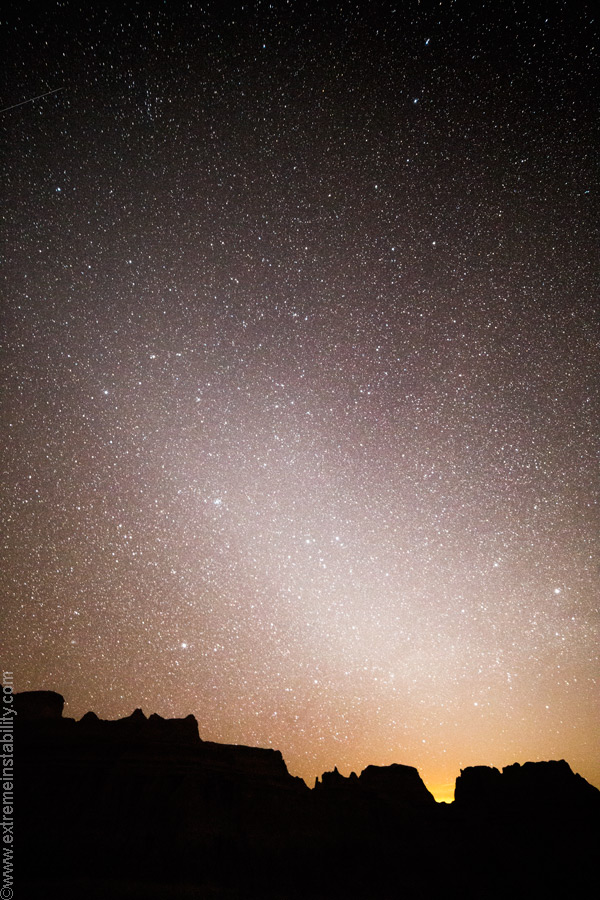
30 seconds F2.8 8000 ISO Samyang 14mm
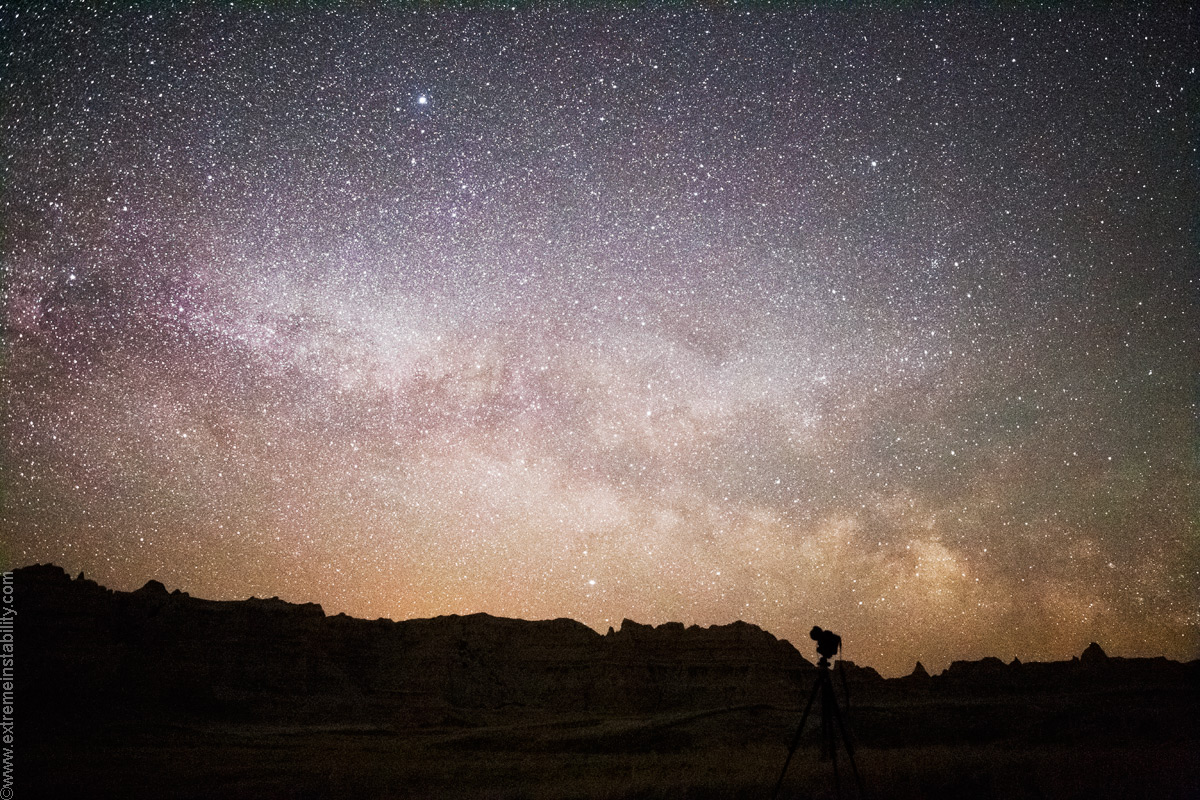
Samyang 24 F1.4 4 seconds 102,400 ISO lol
It would eventually get down to about 20F out here this night. We weren't cold at all as we walked out to where we shot the Zodiacal light, half mile or so from the road. As we sat there for a couple hours, eh we got cold. It gets hard to get motivated when it is late, you are cold and there's nothing much to shoot for the moment. Zodiacal faded and then we waited for the Milky Way to rise, as we warmed up in my car. Once that cold gets into your core, it is hard to warm up and even harder to talk yourself into going back out. Not like it was crazy cold out, we had just sat there too long dealing with it, without the warmer clothing on yet. I put my coveralls on and was then good to go the rest of the night, never really cold.
We got out for a while and noticed this odd look to the sky almost to the north. We had taken some shots to see if there was any airglow and there wasn't. But visually you could see something just above the horizon. We couldn't figure out what it was. Well we soon figured it out. It was actually the crappy end of the Milky Way and we were actually seeing it near the dang horizon. The sky is most clear looking more up off the horizon. It was impressive how well we could see that part as low as it was yet.
I had to fart around with the extreme ISO with the ultra fast F1.4. Above is only 4 seconds at 102,400 ISO lol. The thing is the Milky Way actually blew out at that. This is after I reduced the exposure a long way in post. Full sized example of the noise on the second page with those examples. Seems if you "expose to the right" you could probably avoid the banded patterns that kill those extended ISO ranges. Another I took showed the heavy banding but this one doesn't seem to at all. It is impressive when the Milky Way will blow out starting around 3 seconds.
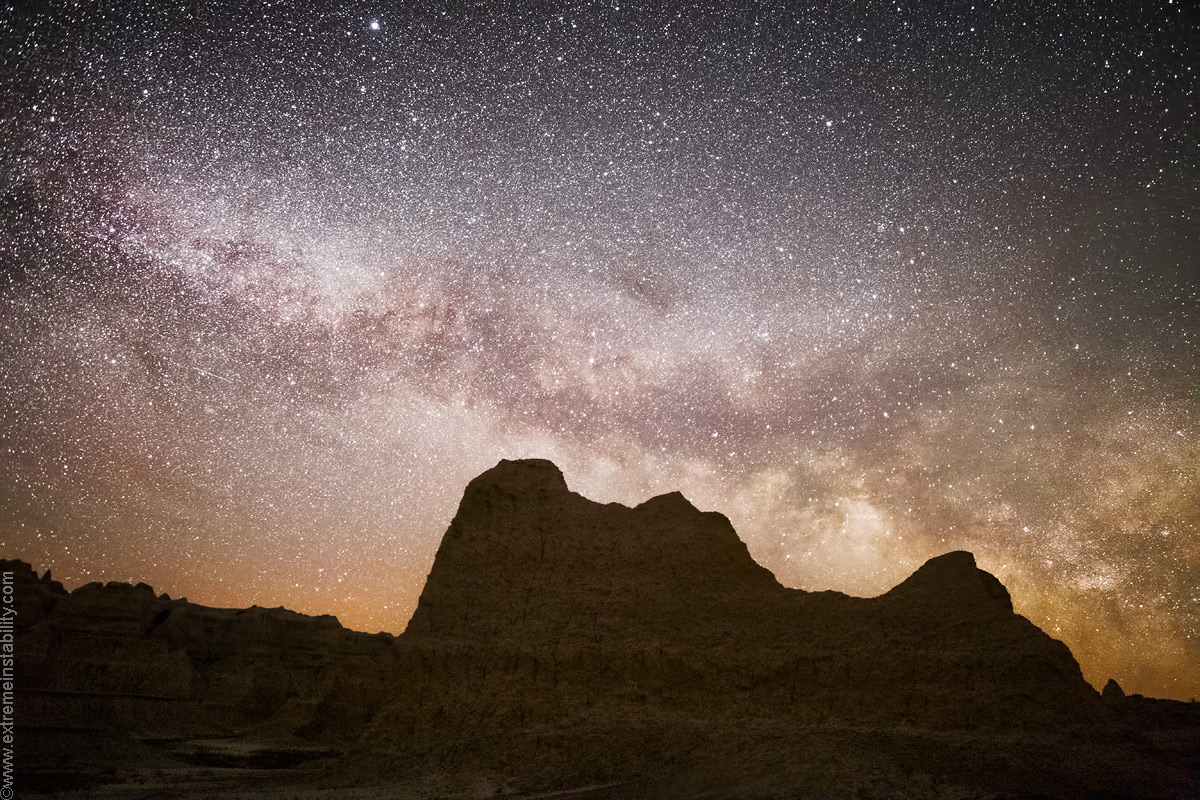
11 seconds, 10,000 ISO F1.4 Samyang 24
Now we are talking. Still the Milky Way is damn low yet. It would start getting epic soon though. There were now two exciting things to conclude. The 6D is a beast for extreme ISO night sky photography. The Samyang 24 F1.4 really is a beast as well! Not the coma whore that Canon *expensive* glass is. Some of that on the second page with large examples.
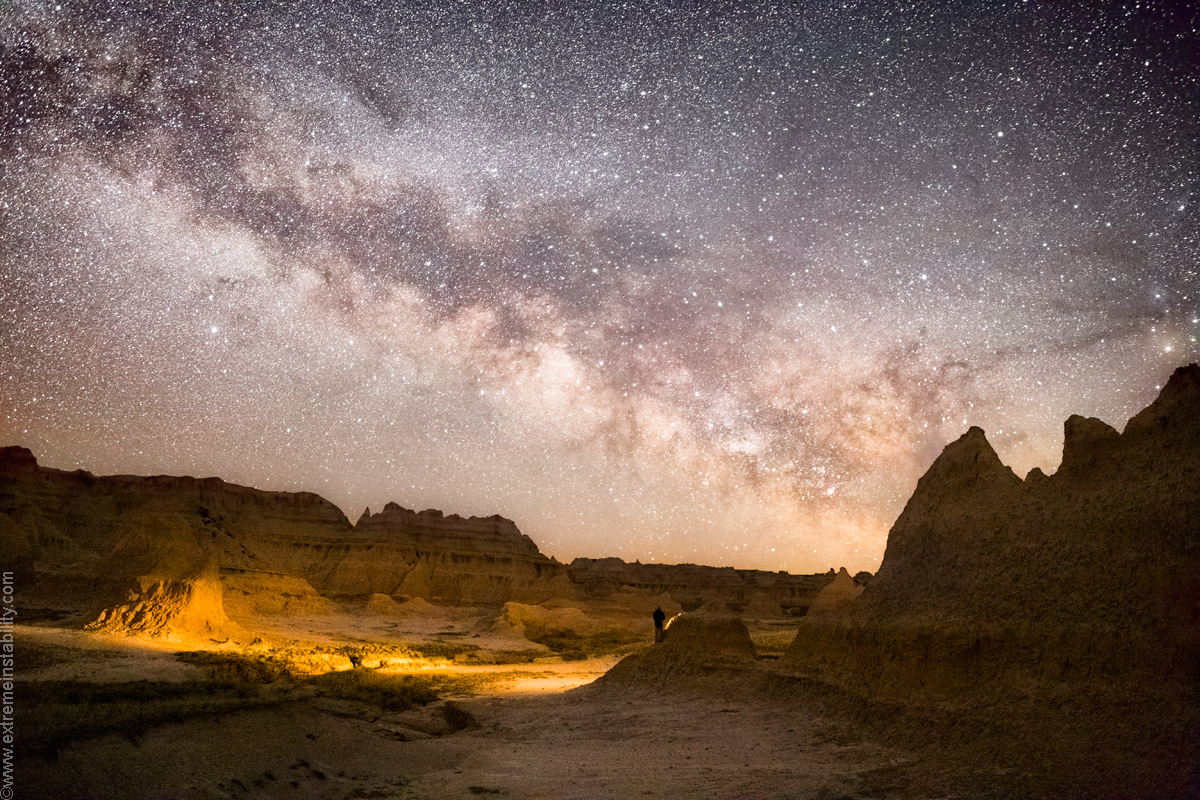
15 seconds, 12,800 ISO Samyang 24 F1.4
Really next to no noise reduction done on any of these except color noise. Remove any on the stars and it does more harm than good. Helps some in the near horizon areas that end up lighter on some. I'd say there's not a lot of worry, even using 20,000 ISO for this sort of stuff, if you need. And really you could need that if you aren't at F1.4. Stars are a moving.
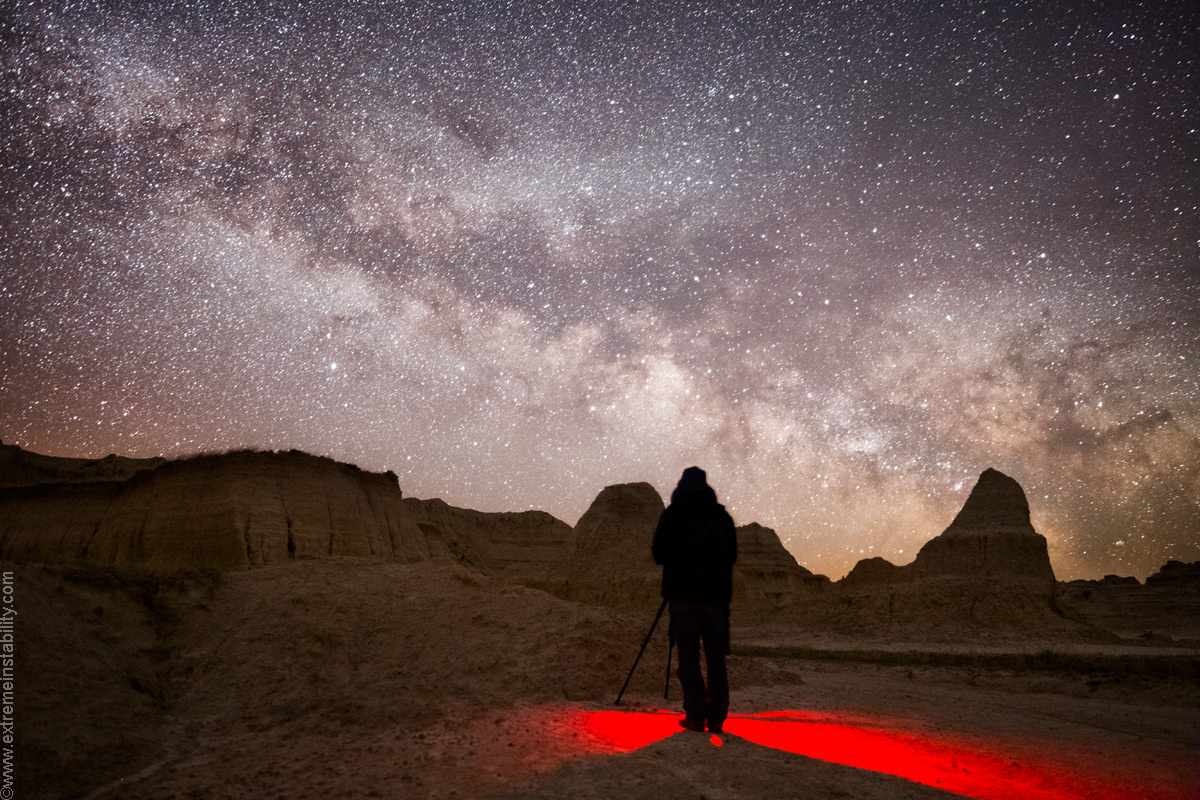
30 seconds, 6400 ISO Samyang 24
It's pretty cool when you feel like 6400 ISO is low. We were a bit blown away by the fact we could see the rocky areas so well. It is super dark there. There was no moon. Just bright ass stars. We'd swear someone had a light on at times or a car was somewhere nearby. Walking in the grass not so much. Had to use flashlights to walk with as there are rattle snakes there and a trillion cacti this year, jeez. We should have done more to show the vertical view, as above us it was really jet black. Now I want to go back lol. Never thought to vertical the 14mm.
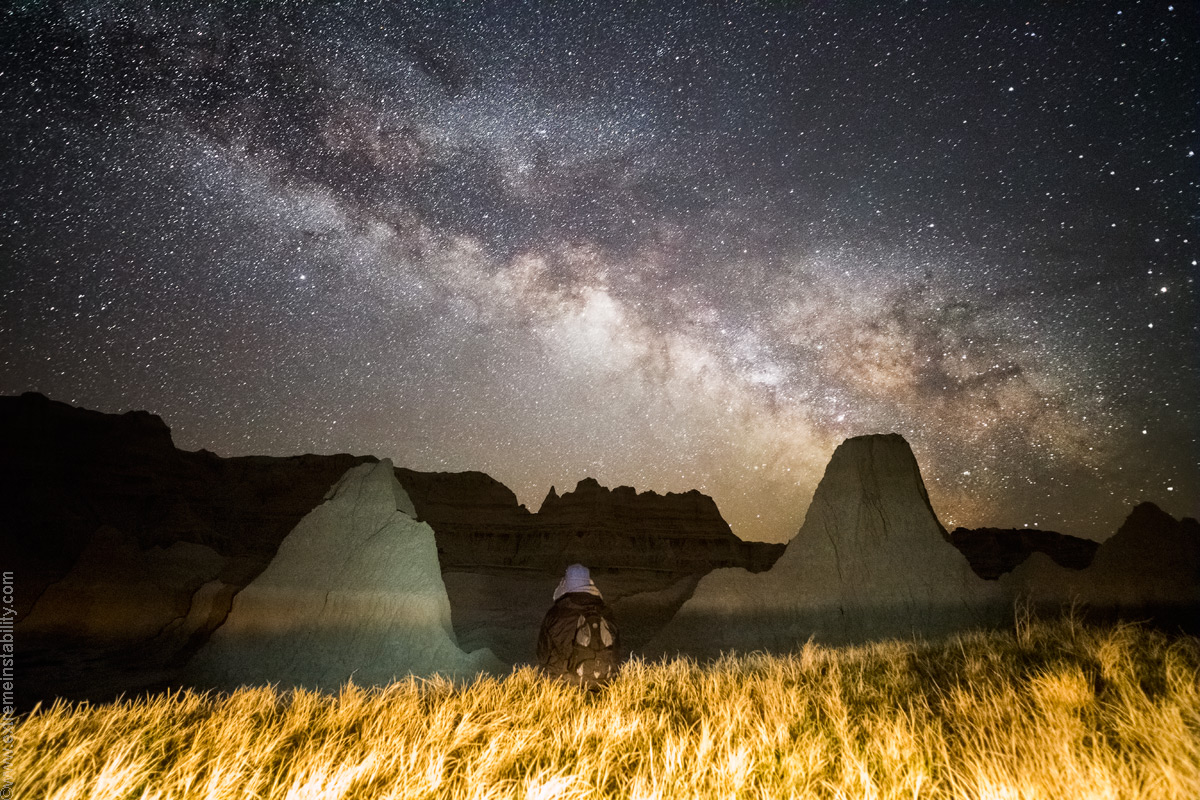
28 seconds, 12,800 ISO F2.8 Zeiss 21mm
The 21mm Zeiss is a crazy sharp lens but it's just not F1.4. We kept thinking how cool even a 21mm F1.4 would be. 18mm F1.4 even cooler or F2 even. You'd think someone would muster out something wider than 24mm that is say F2 or better. Sure it would be expensive but it would probably have a lot of buyers.
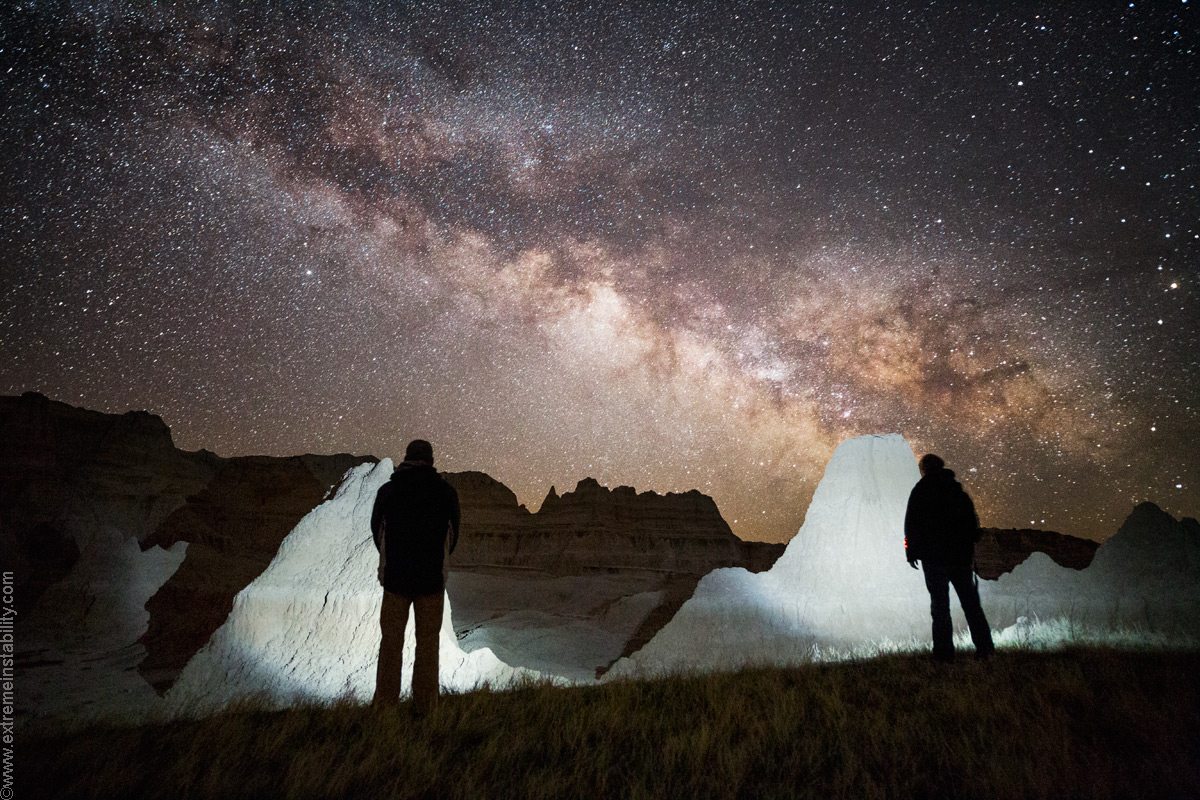
30 seconds, 12,800 ISO F2.8 Zeiss 21mm
Not sure what we were doing.
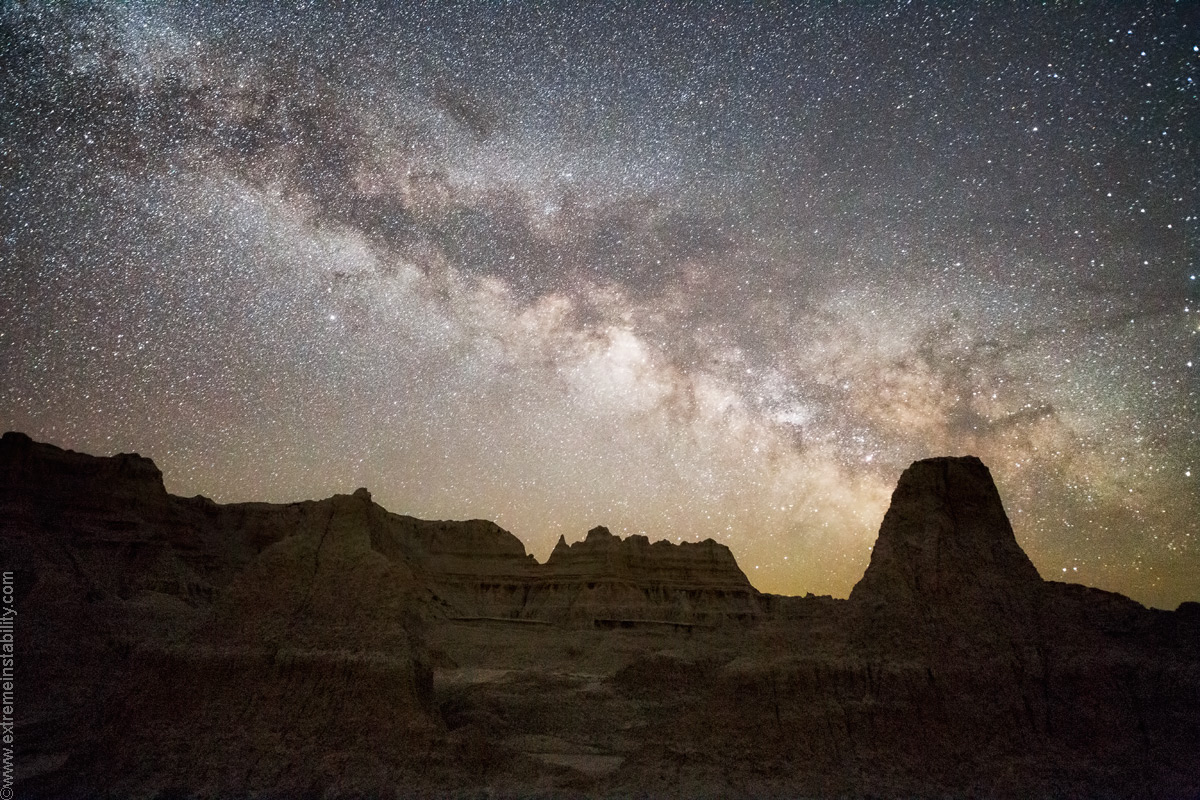
25 seconds, 25,600 ISO F2.8 Zeiss 21mm
You really can get by at 25,600 ISO for this on the 6D. Better to be at two less stops of ISO on a 2 stop faster F1.4 lens though. I was pretty pumped when we came across this mini-devil's tower thing in there btw.
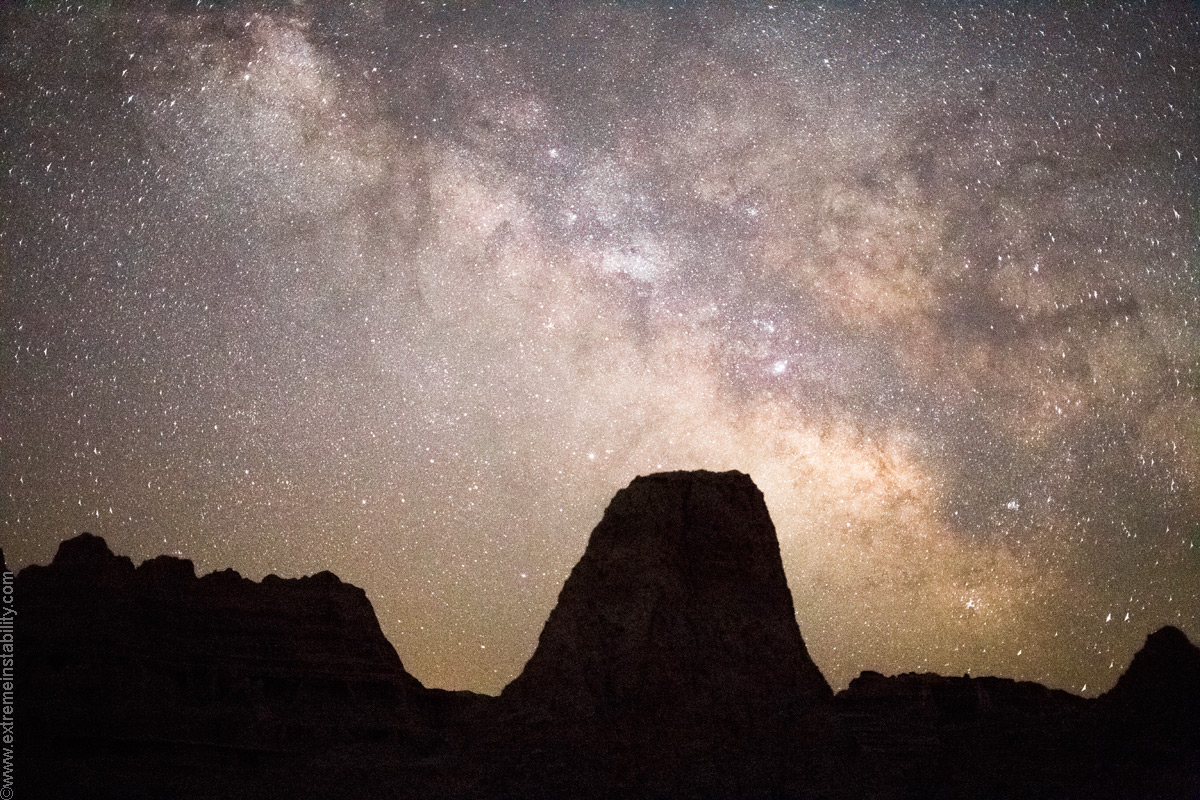
3 seconds, 25,600 ISO F1.4 Sigma 50mm
Like all the fast Canon wide to normal range glass, the Sigma 50 has too much coma full frame for it to be very star friendly. Don't even need to show a full sized crop to see the wings in the corners.
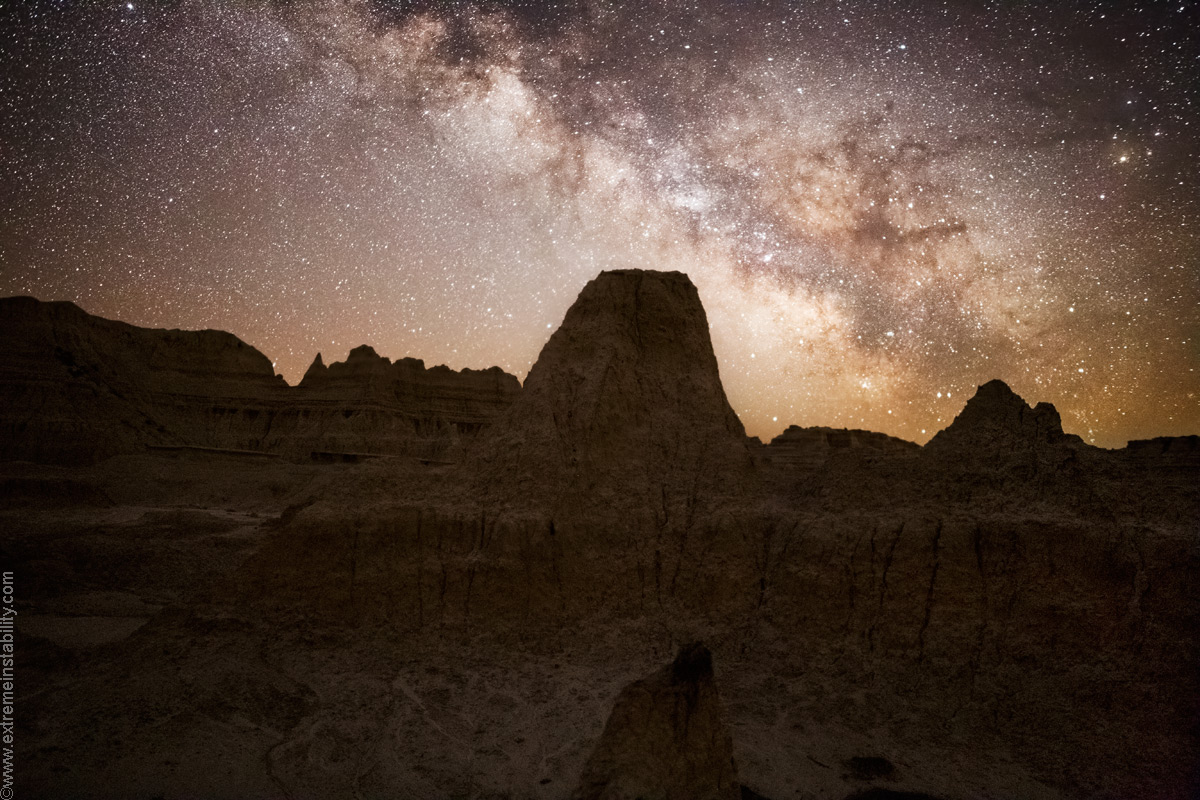
14 seconds, 10,000 ISO F1.4 Samyang 24
Simply put, the Samyang 24mm F1.4 should be in everyone's kit if they shoot the night sky. It's perfectly fine at F1.4 and doesn't have the coma issues. Some coma but not much. Even the Zeiss 21 at F2.8 has some coma. I'm so thankful for Samyang, so so thankful. They've made it pretty easy to afford a F2.8 14mm and F1.4 24mm and they both simply kick ass at the same time! As far as the 14mm lenses are concerned, the Samyang edges the Canon out and blows it out when it comes to coma. You could buy 5 or more of them for the price of the one Canon 14....lol.

15 seconds, 12,800 ISO F1.4 Samyang 24
Hello epic night sky! As the Milky Way got higher more insane views were on the LCD and in the sky to our eyes. The one time I was like, dude there's so much happening right there it looks like the Milky Way has mammatus! Some cool images can be had if you get some people standing on top of formations like we did here once before. We tried that here but all our formations here were smaller and the peaks tiny points you could not stand on.
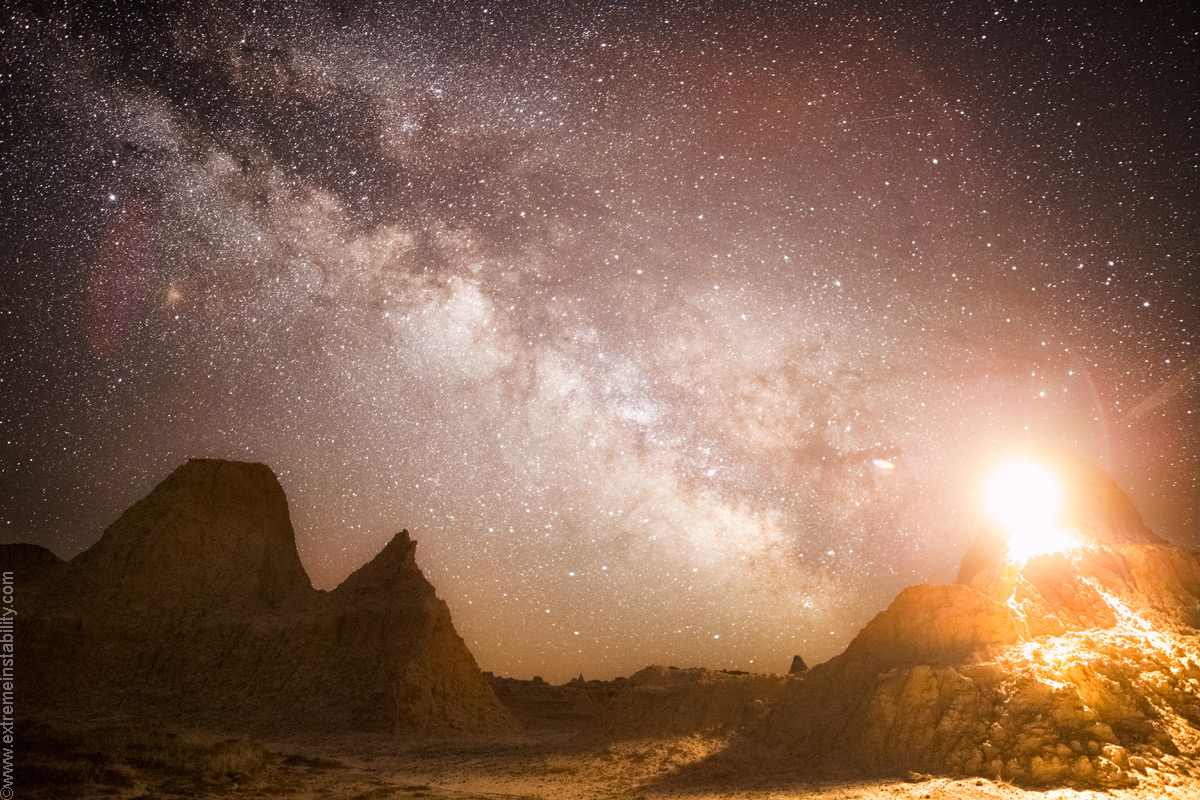
Climbing back down as my camera continues to fire off 15 second shots.
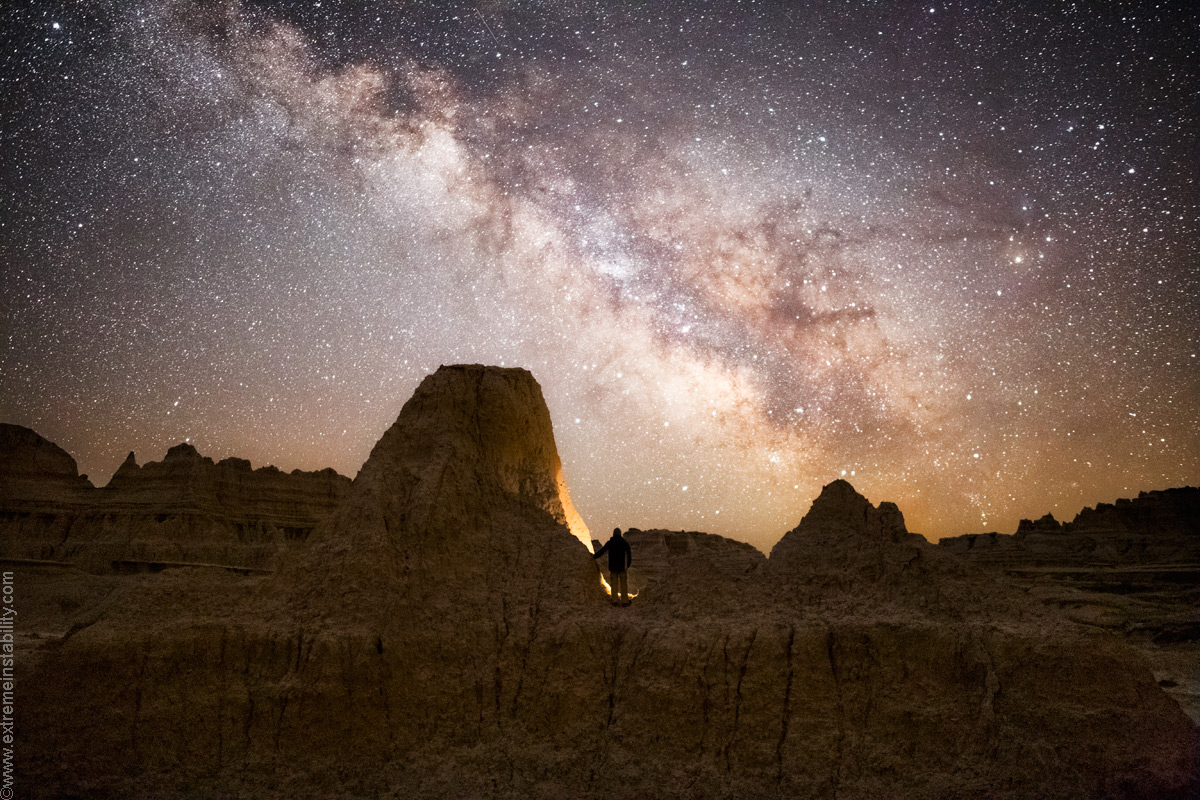
15 seconds 10,000 ISO now, still F1.4 Samyang 24. I wanted on that mini-devils tower so bad.
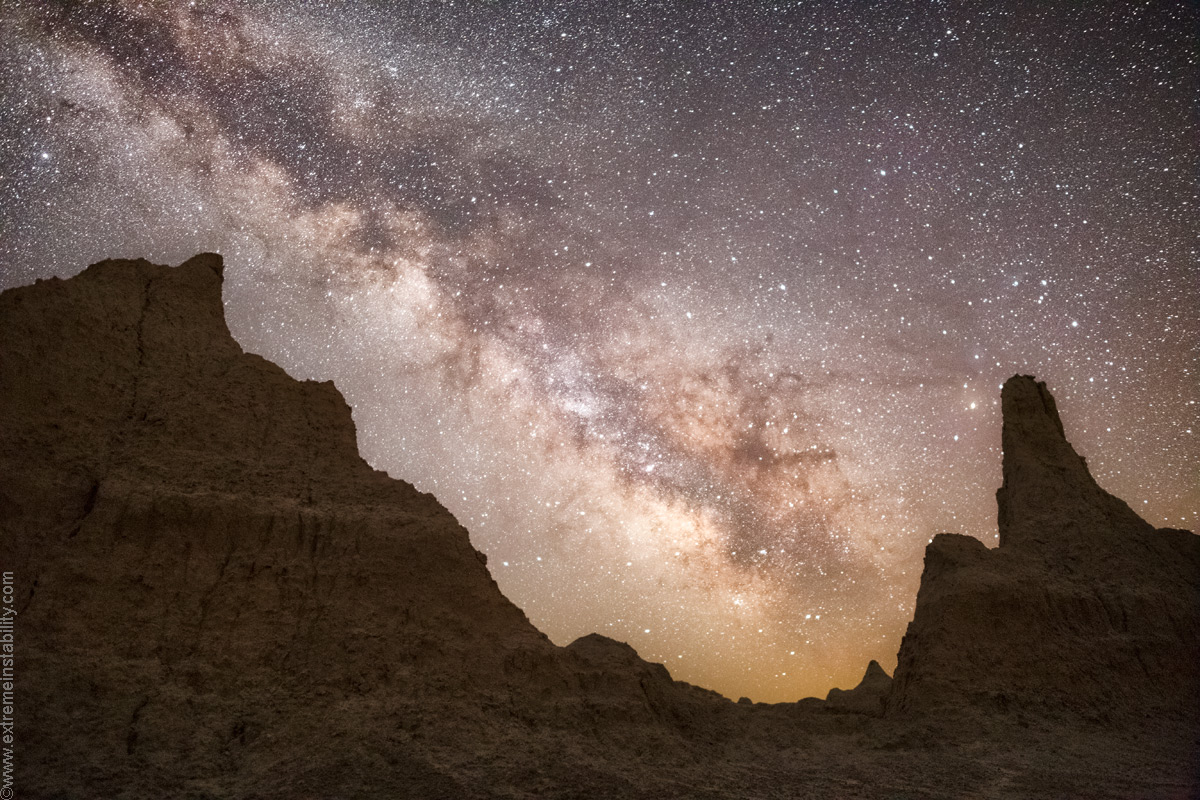
15 seconds, 10,000 ISO F1.4 Samyang 24 We weren't lighting up these rocks with anything. Just star power.
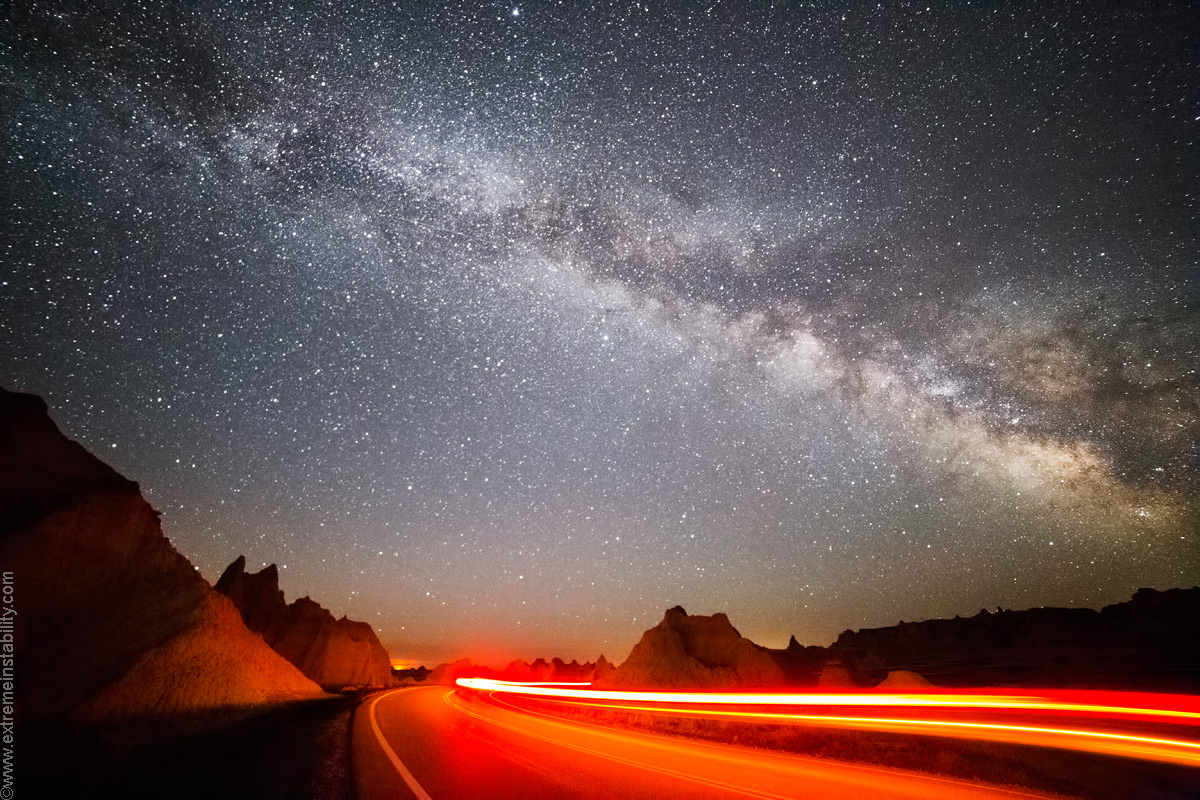
20 seconds, 12,800 ISO Samyang 14 at F2.8
I think when Chris looked up the moonrise time on wunderground he had the 3rd date and didn't change it to the 4th. I do that all the time. It sure wasn't rising when we thought and was late. Hard to know for sure when you don't have a view of the horizon. But it was "late". We move over here and think it is rising to our left but that was Wall SD, which I knew but wasn't remembering lol. We set up to shoot car lights under the Milky Way. Then all the sudden, oh crap there is the moon and it happens to be rising right over our road. You can tell it is in clouds. Those are the clouds with that bigger upper low to the east backing up west. This is how small our gap/shot was in being in the clear. There to just west of us barely where the clouds were dying out thanks to this system backing up west.
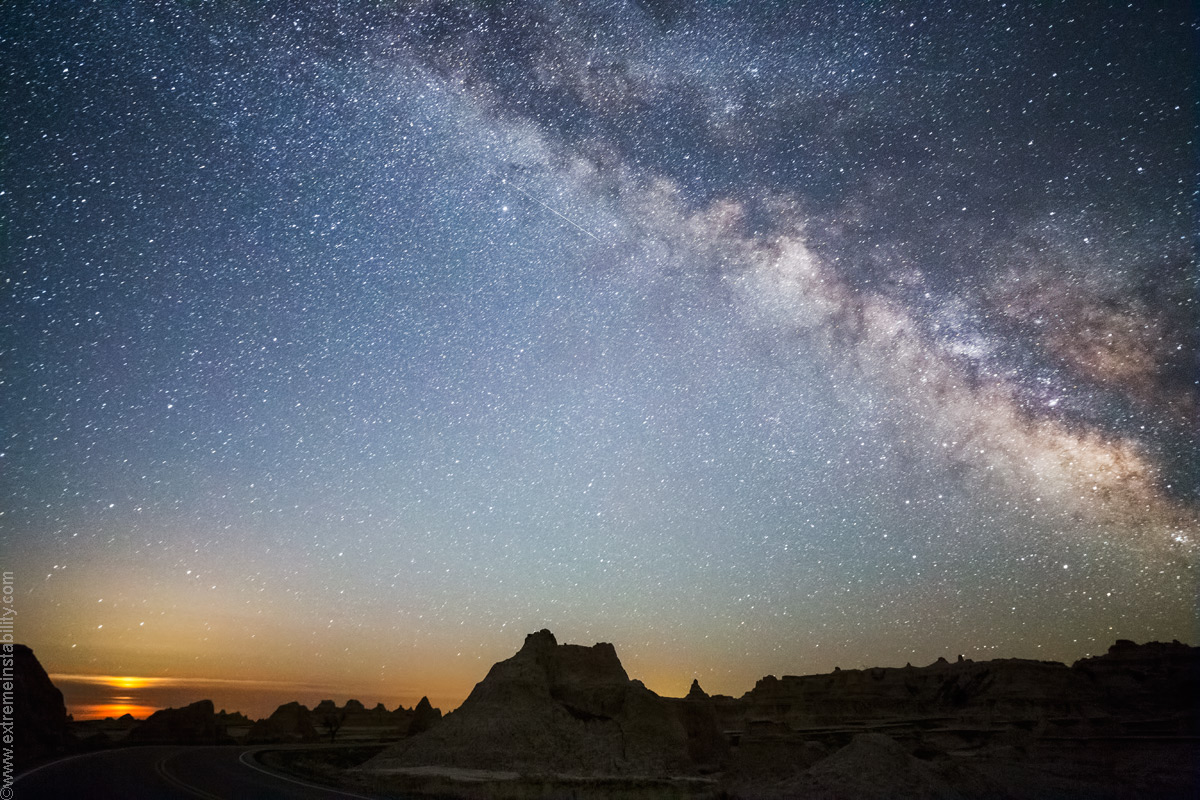
38 seconds, 12,800 ISO Samyang 14 at F2.8
Pretty cool how much it ends up looking like the sun is rising.
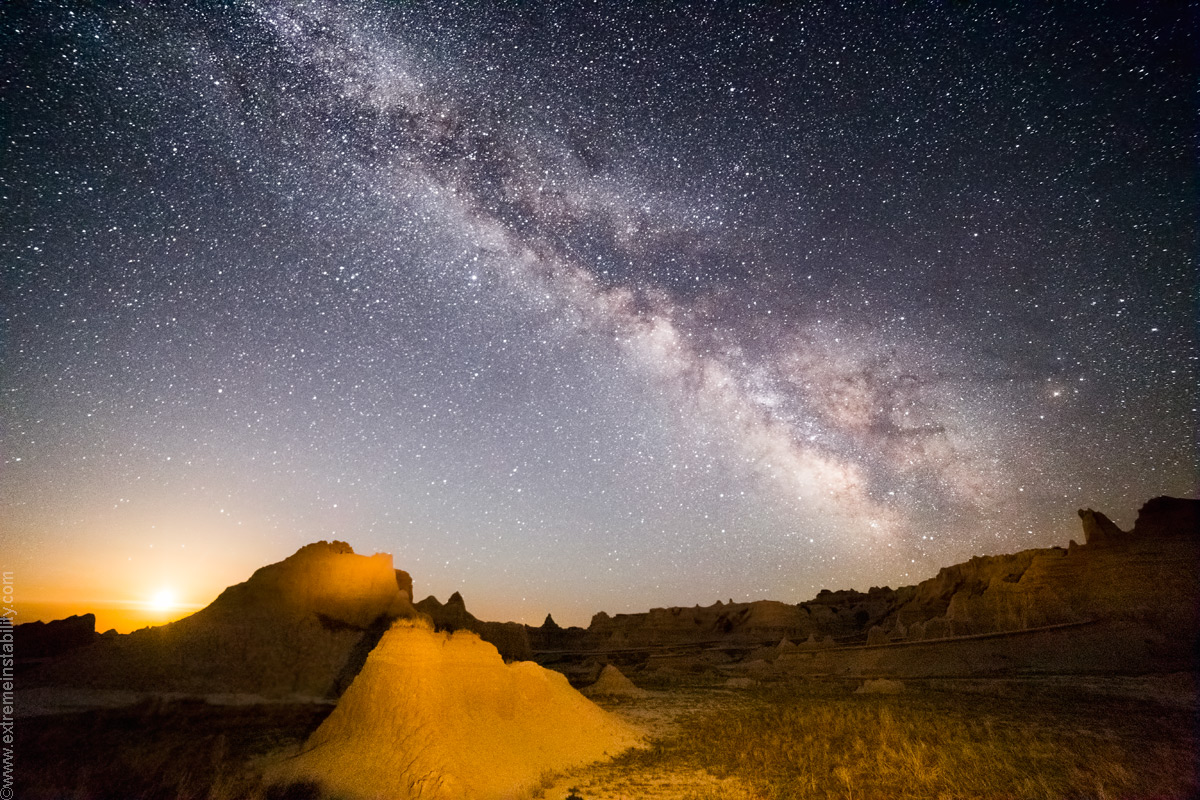
23 seconds, 8,000 ISO Samyang 14 at F2.8
I wondered over here into the land of amazing photo ops at the moment.
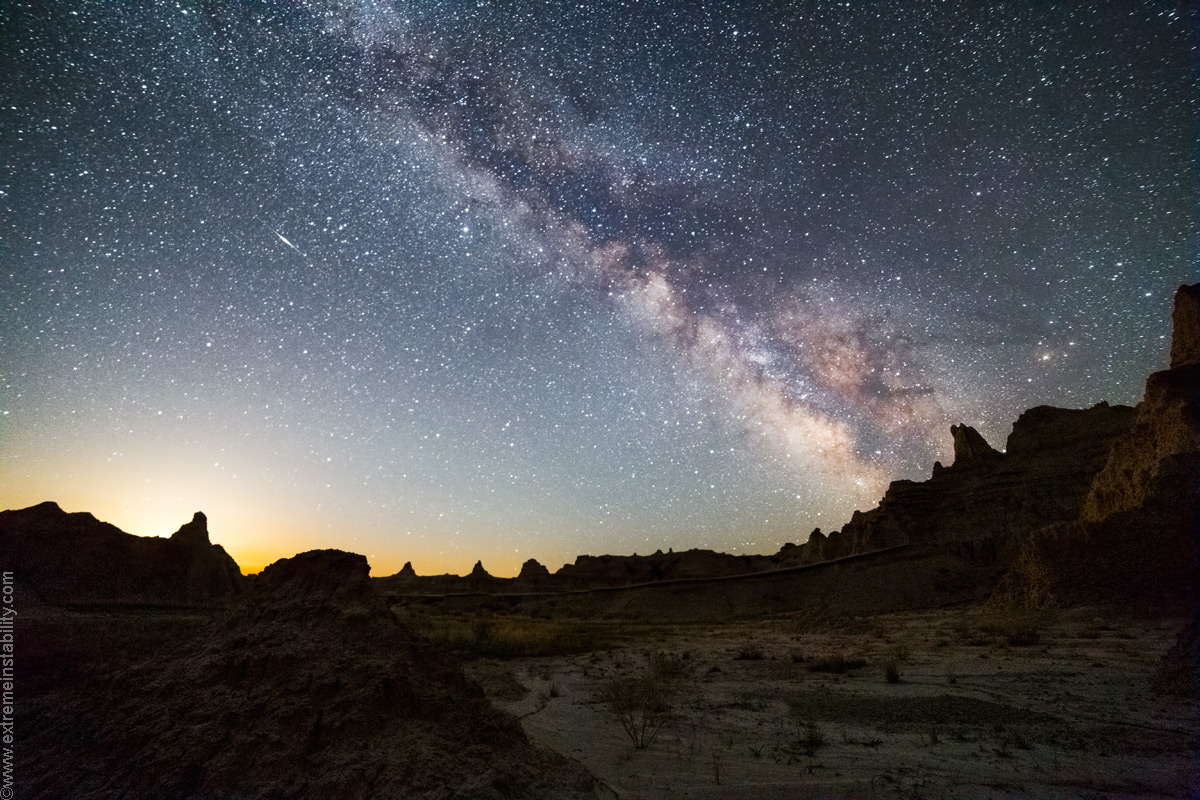
28 seconds, 8,000 ISO Samyang 14 at F2.8
Satellite flare up there.
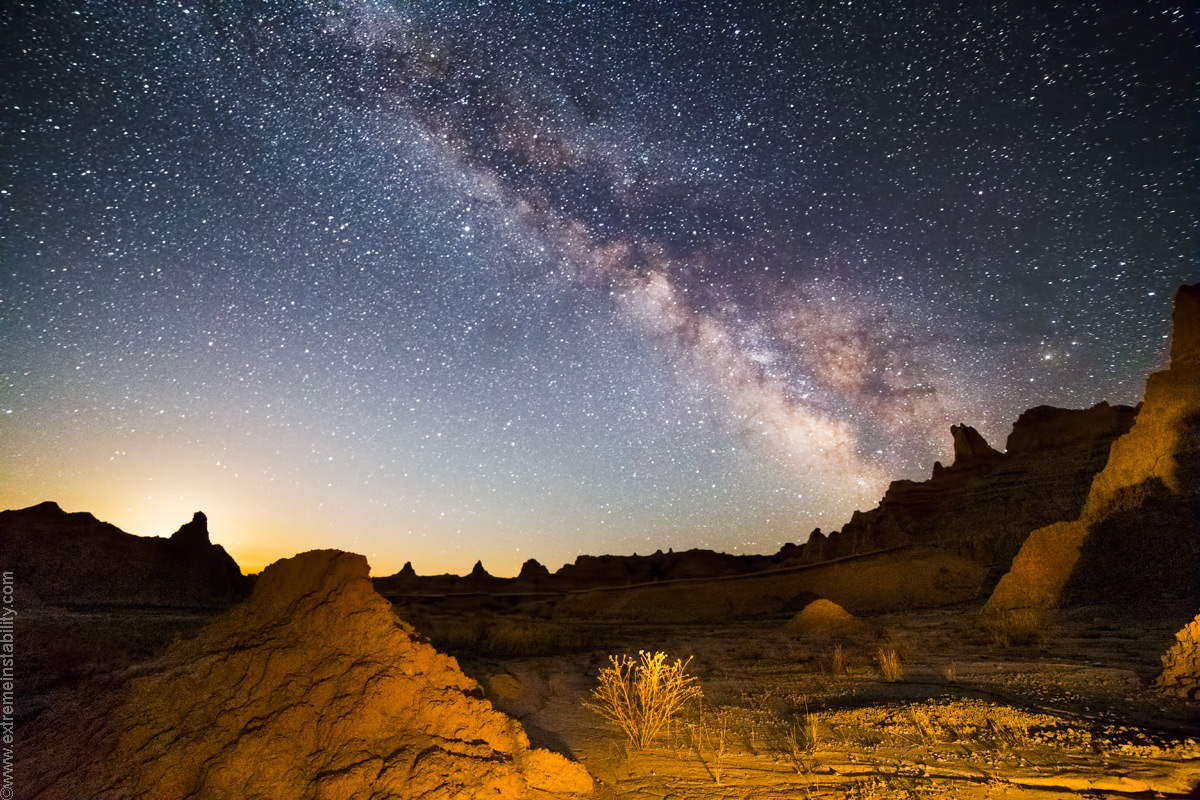
32 seconds, 8,000 ISO Samyang 14 at F2.8
Wish I had done more with this op in here. Chris had the 24 right now too. I eventually yelled for him to get over here lol.
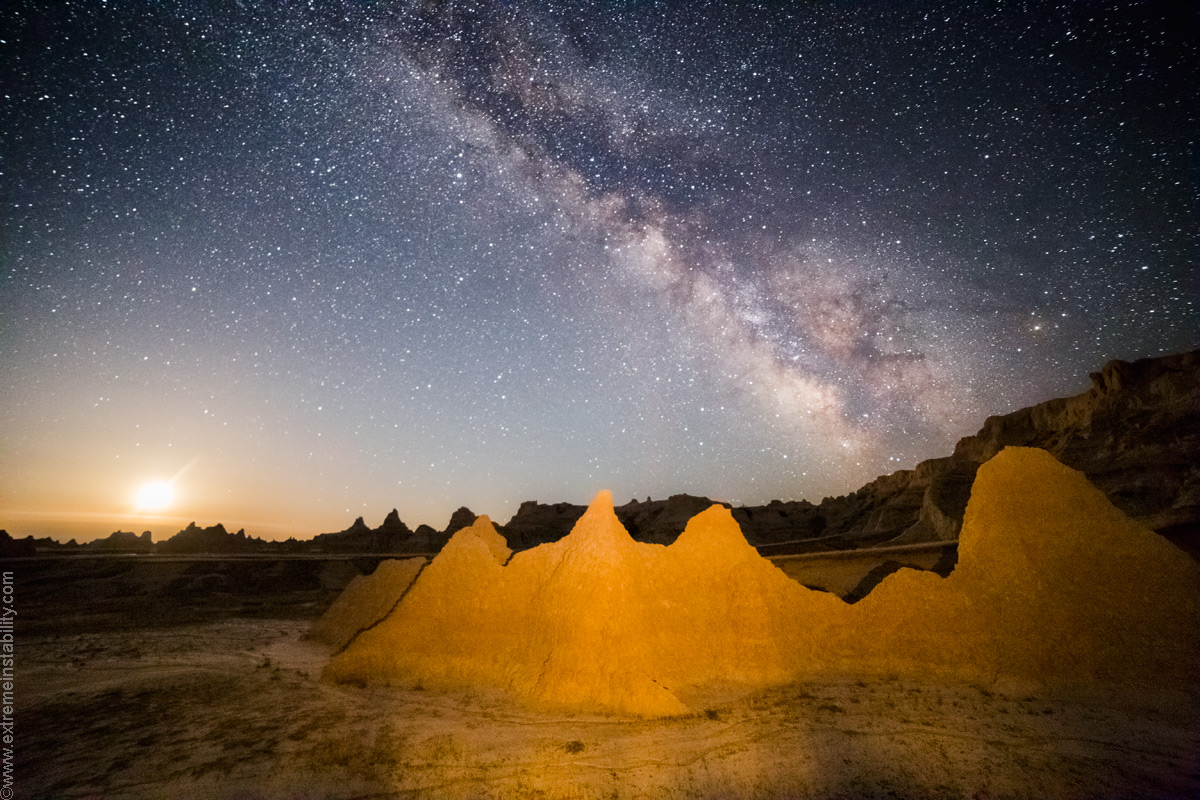
25 seconds, 10,000 ISO Samyang 14 at F2.8
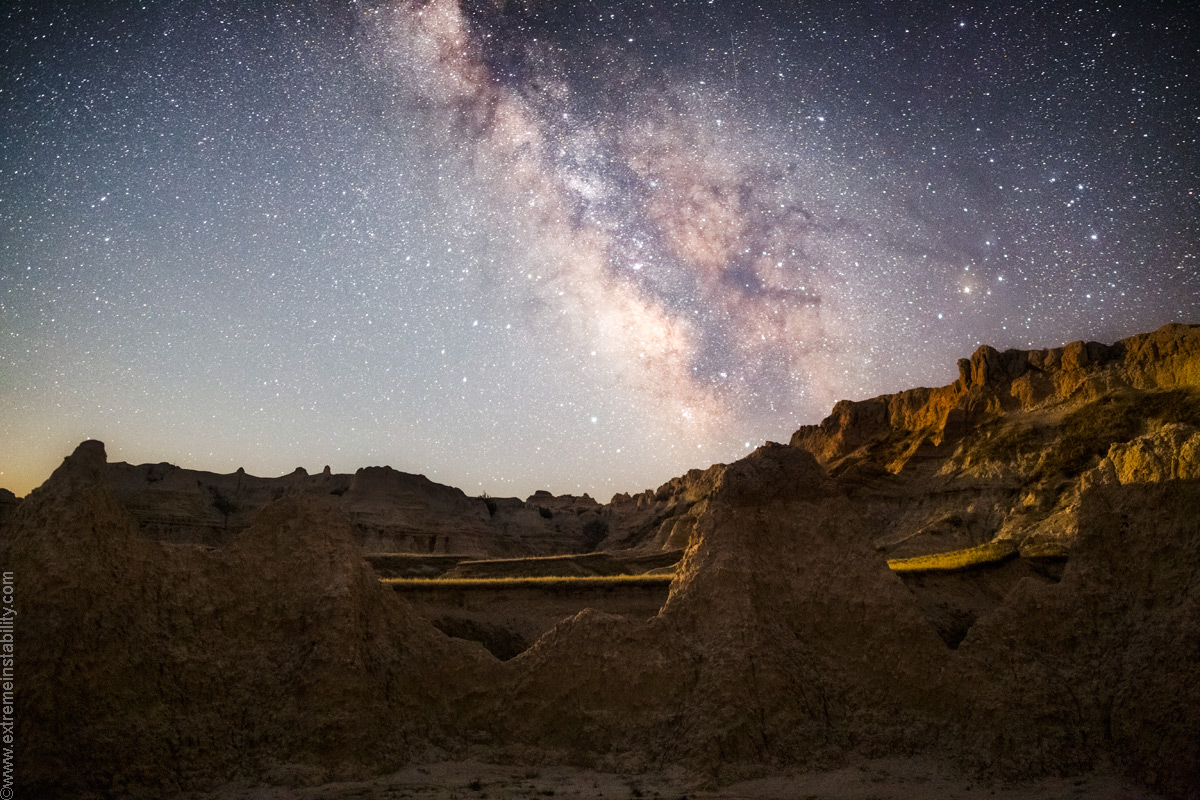
As much moonlit ops we try and shoot, you'd think I'd have thought of that with the Milky Way. Nope, not till it was happening. Thought, ah crap, need my 24mm back now and get the moon lighting up the terrain with Milky Way above.
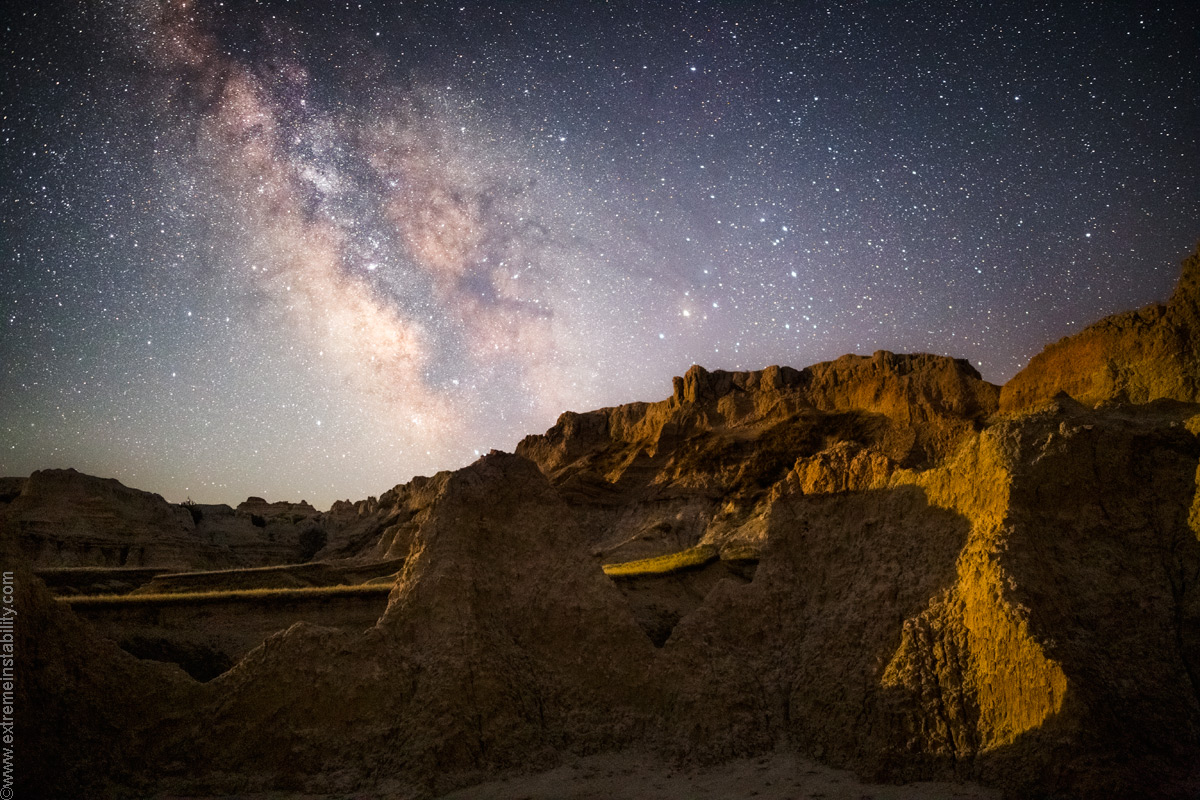
As the moon rose higher it would dim the Milky Way down some eventually. I began thinking, I've got all I could hope for out of this night. Now I need to zip home and not spend money on a motel room. See the best you can do for sleep is get the room around noon and nap there all day. Then you shoot again that night. Then early that next morning you go back to your room and nap a couple hours, then hit the road home. That is the best approach, plan on 2 nights and one motel room like that. Still the drive home will be tired. I felt like I could do it right now without any sleep. So I flew out of there at 3:30 a.m. mountain time, a bit over 12 hours after I left home to go out there. The interestate is so nice at that hour. No one. I was fine till about Chamberlain. Chamberlain to Sioux City was a really hard drive, staying awake. The damn cold rain by Sioux Falls wasn't helping. Like serious sleepy weather. Had thought the sun rising would help me a couple hours after leaving but instead I drove into clouds and rain, doh. Doing this stuff zaps you for days. I then have to do all these images and put them on here. More zapping. Then get ready to leave for a storm chase and do it all again. Least something is happening now finally.
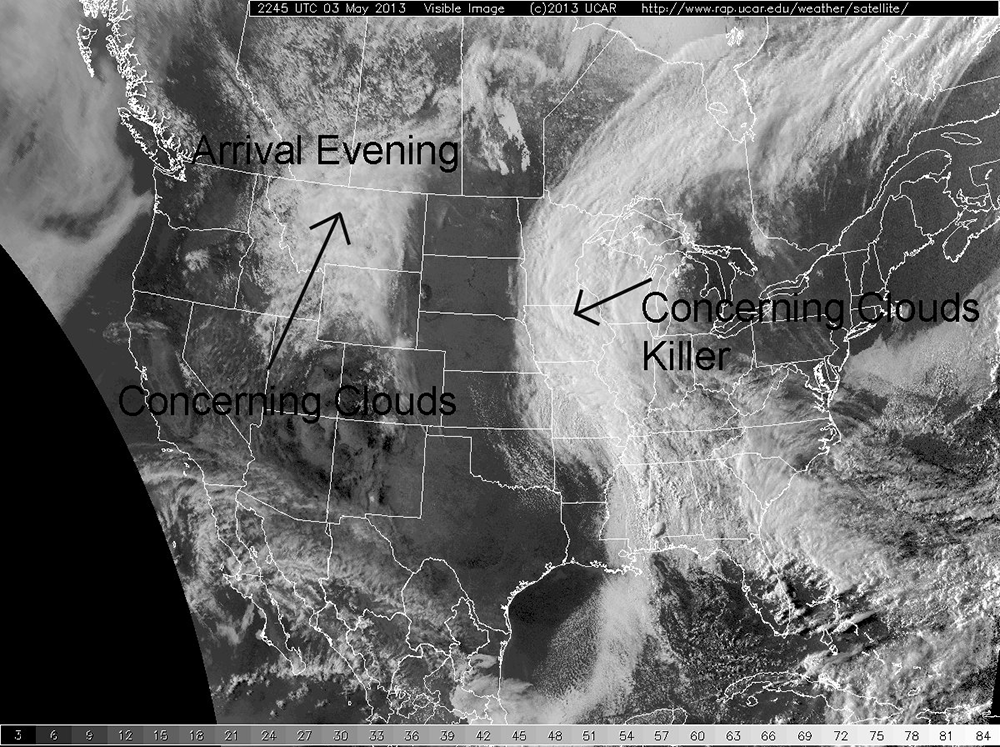
Here is a 2 frame gif showing the arrival evening clouds and how the upper low to the east pivots back west and is killing them with the sinking air behind it. The long infrared loop of that is impressive. The MT/WY clouds would have surely moved on over by sunset had the low to the east not moved back west. It's fairly hard to trust that will kill all the clouds even if the models insist on it. Going for it paid off though. Some patterns getting clear skies isn't an easy task and most of this year so far is one of them. Always cloudy.
Second page has a lot of large images showing lens qualities and extreme ISO noise levels. Click below.







